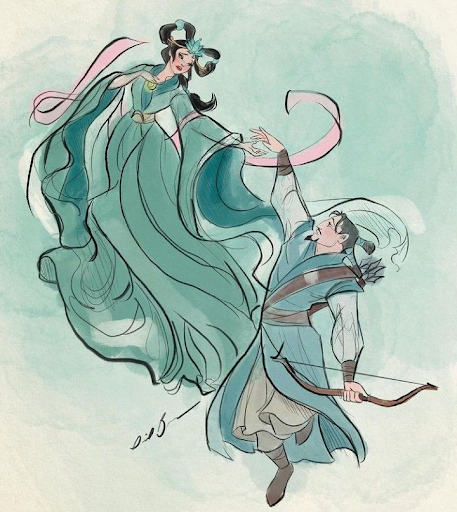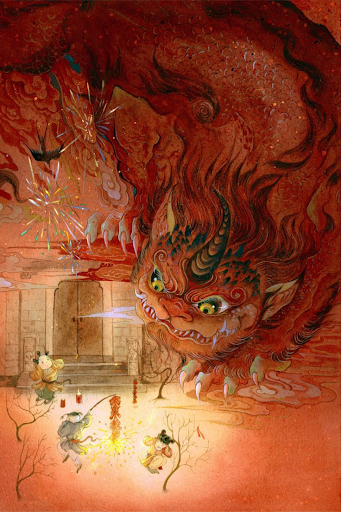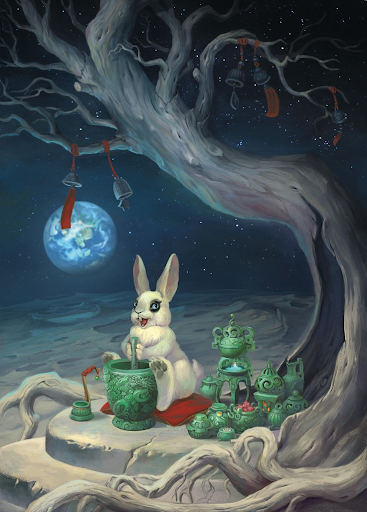Every culture has their own collection of mythical stories that are passed down through generations. I’m sure we’re all familiar with several Greek myths, such as Theseus and the Labyrinth. In honor of the approach of Lunar New Year, let me introduce you to three captivating Chinese myths that will leave you in awe.
- The Chinese Moon Goddess: Chang’e
 The legend of Chang’e is closely connected with the Mid-Autumn Festival, which occurs on the 15th day of the 8th month. In ancient times, the festival was a tradition held for emperors to celebrate the year’s harvest by offering tributes to the moon, along with hosting a feast. According to Chinese mythology, there were once ten suns in the sky, which caused widespread suffering due to the scorching heat. An archer named Hou Yi heroically shot down nine of the ten suns to save humanity. The Heavenly Queen Mother expressed her gratitude by rewarding him with the elixir of immortality. Hou Yi however, was devoted to his wife, Chang’e. Consequently, he left the elixir with Chang’e for safekeeping, in fear that he would be separated from her if he consumed it. One day, after discovering the elixir, one of Hou Yi’s apprentices made an attempt to steal it while Hou Yi was away. Chang’e knew that she was entrusted with protecting the elixir, so in a moment of desperation, she consumed it and transformed into an immortal being. Moments after drinking it, Chang’e began to ascend upward toward the moon. There, she became the immortal Moon Goddess and was eternally separated from her husband. After discovering this tragedy, Hou Yi was devastated. In his sorrow, Hou Yi looked up at the moon and came to the realization that the moon was shining just as brightly and beautifully as before. He understood that even as the Moon Goddess, Chang’e was still with him in spirit, always watching over him. To honor her, Hou Yi would place offerings such as her favorite fruits on a table during the Mid-Autumn Festival. The Mid-Autumn Festival is still celebrated today, and the love between Hou Yi and Chang’e became a foundation for the festival’s celebration.
The legend of Chang’e is closely connected with the Mid-Autumn Festival, which occurs on the 15th day of the 8th month. In ancient times, the festival was a tradition held for emperors to celebrate the year’s harvest by offering tributes to the moon, along with hosting a feast. According to Chinese mythology, there were once ten suns in the sky, which caused widespread suffering due to the scorching heat. An archer named Hou Yi heroically shot down nine of the ten suns to save humanity. The Heavenly Queen Mother expressed her gratitude by rewarding him with the elixir of immortality. Hou Yi however, was devoted to his wife, Chang’e. Consequently, he left the elixir with Chang’e for safekeeping, in fear that he would be separated from her if he consumed it. One day, after discovering the elixir, one of Hou Yi’s apprentices made an attempt to steal it while Hou Yi was away. Chang’e knew that she was entrusted with protecting the elixir, so in a moment of desperation, she consumed it and transformed into an immortal being. Moments after drinking it, Chang’e began to ascend upward toward the moon. There, she became the immortal Moon Goddess and was eternally separated from her husband. After discovering this tragedy, Hou Yi was devastated. In his sorrow, Hou Yi looked up at the moon and came to the realization that the moon was shining just as brightly and beautifully as before. He understood that even as the Moon Goddess, Chang’e was still with him in spirit, always watching over him. To honor her, Hou Yi would place offerings such as her favorite fruits on a table during the Mid-Autumn Festival. The Mid-Autumn Festival is still celebrated today, and the love between Hou Yi and Chang’e became a foundation for the festival’s celebration.
 The Legend of Nian
The Legend of Nian
Have you ever wondered where Chinese New Yearoriginated from? Why is red the color of good luck? Why do we set off fireworks?
A long time ago in ancient China, lived a great beast named “Nian”. The creature was described as having a head that looked like a lion’s, with a single sharp horn,used to attack its prey. Nian lived at the bottom of the sea and would only emerge on the last day of the Lunar New Year to eat people and livestock. To avoid being eaten, people locked the livestock gate every year and fled to the mountains. One year, an old man approached one of the villagers and claimed that he would drive the beast away. The villagers, too frightened to believe him, brushed him off and fled before night fell. As he did yearly, Nian attacked the village and prepared to devour its prey. All of a sudden, firecrackers went off and bright flares shot into the sky. The old man that had previously approached the villagers showed himself dressed in red. This attire threw the beast into a panic. Terrified, Nian ran off. The following day, the villagers returned and found that their village was not destroyed. They realized that the old man was actually a celestial who came to their aid. The old man told them that there were three things that would drive the creature away. One, items that are red. Two, bright lights. Three, firecrackers. From then on, during Lunar New Year, people hung up red lanterns, set off fireworks, and kept their lights on to protect themselves from Nian. Today, we still follow these customs by handing out red envelopes, wearing traditional red Chinese clothing, lighting candles, etc.
 The Jade Rabbit
The Jade Rabbit
The Jade Emperor is known as the first emperor of China and the supreme ruler of Heaven. In this myth, the emperor disguises himself as a poor, starving old man and begs for food from a monkey, an otter, a jackal, and a rabbit. Each animal goes off to collect some food for him. The monkey climbed the trees and gathered some fruits. The otter caught some fish from the river and the jackal stole a lizard and a pot of milk. Unlike the others, the rabbit offers itself as food and sacrifices its life in the fire that the old man had started, since it could only gather grass. Surprisingly, the rabbit wasn’t burned. The old man suddenly transformed back to his original form and revealed himself as the Jade Emperor. The emperor was touched by the rabbit’s selfless sacrifice and rewarded it by sending it to the moon to become the immortal Jade Rabbit. If you remember from before, Chang’e was also sent to the moon after consuming the elixir and becoming the immortal Moon Goddess. Now, both Chang’e and the Jade Rabbit accompany each other on the moon. In literature, Chang’e is often described alongside the rabbit. Sometimes, the Jade Rabbit can be seen preparing the elixir of life for the immortals. Perhaps if you look up to the bright and beautiful moon on Lunar New Year, you’ll catch a glimpse of Chang’e and the Jade Rabbit.
Now that you’ve read about these three myths, have your perspectives about Lunar New Year changed? Naturally, there are hundreds of other Chinese mythologies, but these are just some of the more well-known ones. Each myth is told slightly differently, and there are multiple variations of each story. Have you heard of other versions of these tales?
SOURCES:
- Tale of Chang’e: Chinese Moon Goddess . ASIAN LANGUAGE SCHOOL. (2023, September 25). https://www.asianlanguageschool.com/chinese-moon-goddess/
- Moon festival: Facts and traditions. Tandem. (n.d.). https://tandem.net/blog/mid-autumn-festival \
- The Legend of the Beast Nian – Origins of Chinese New Year. Confucius Institute for Scotland. (2021, February 26). https://www.confuciusinstitute.ac.uk/the-legend-of-the-beast-nian-origins-of-chinese-new-year/
- Guardian News and Media. (2016, February 8). Top 10 Chinese Myths. The Guardian. https://www.theguardian.com/childrens-books-site/2016/feb/08/top-10-chinese-myths
- The White Jade Rabbit – Legends from the Moon Palace – Shen Yun Performing Arts. Shen Yun Performing Arts | The White Jade Rabbit – Legends from the Moon Palace. (n.d.). https://www.shenyunperformingarts.org/explore/view/article/e/9g-WPxuH_YU/white-jade-rabbit-goddess-of-the-moon#:~:text=Cute%2C%20fluffy%2C%20and%20white%2C,company%20in%20the%20Moon%20Palace.
Chueh, I. (Pi-fen). (2024, April 19). Year of the Rabbit: Auspicious Blessings from the Moon goddess, chang’e. University of Alberta Museums. https://www.ualberta.ca/en/museums/news/2023/january/year-of-the-rabbit.html#:~:text=In%20Chinese%20culture%20the%20rabbit,other%20forms%20of%20material%20culture.





